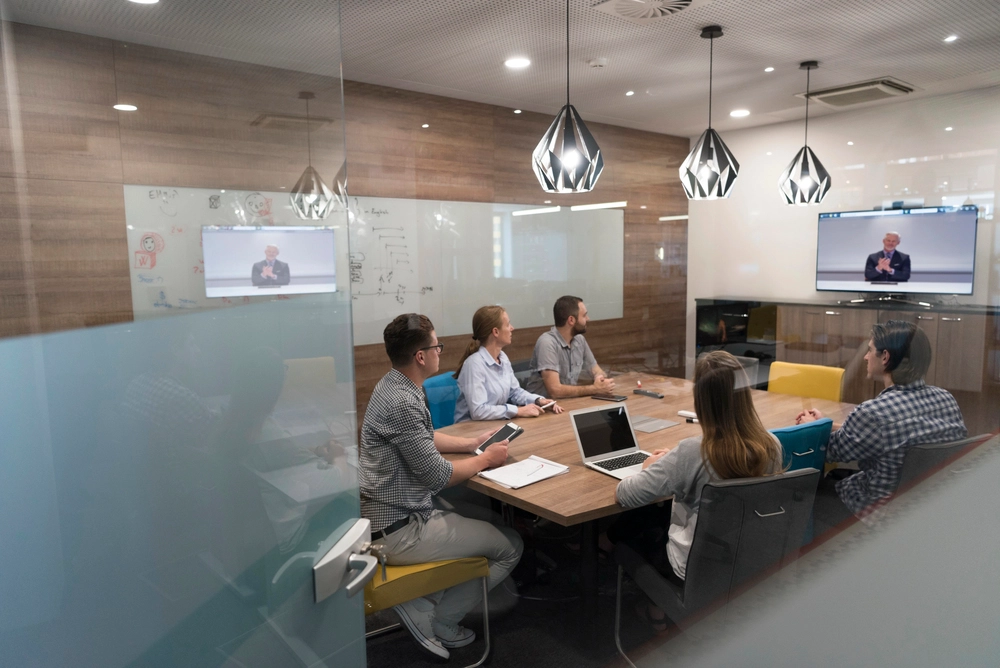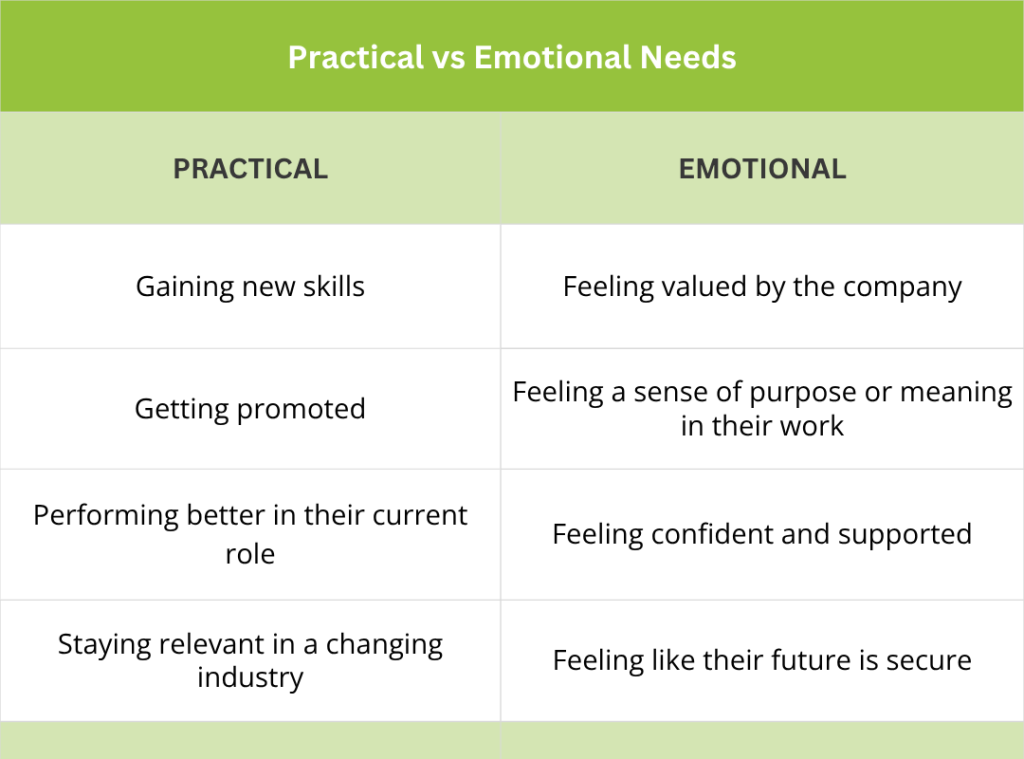Why Learning is the Key to Long-Term Employee Engagement and Retention
Employees are speaking loud and clear: 94% would stay longer if their company invested in their careers. That’s why, in this article, we’re unpacking how learning can be a key lever for employee engagement and retention.

In 2024, employee engagement sank to its lowest level in over a decade.
Why? Employees are seeking role clarity, a deeper connection to their company’s mission, and work that truly matters.
Free pizza and ping-pong tables just don’t cut it for today’s workforce. They want meaningful growth opportunities that align with their career goals and equip them with the skills needed to stay competitive and adapt to shifts in technology and business.
Learning and development (L&D) teams have long recognized this shift and it’s now more critical than ever for organizations to respond strategically.
In this article, we’ll cover why career growth, delivered through purposeful learning, is one of the most impactful strategies organizations can use to increase employee engagement and retention.
How Learning Drives Employee Engagement and Retention
Career development is a critical driver of engagement and long-term retention. In fact, 94% of employees would stay at a company longer if it invested in their careers.
Why does learning have such a strong impact?
Because purposeful learning directly supports the top things employees value in their work experience: opportunity, growth, and meaning.
When employees are given the opportunity to build new skills, apply their knowledge in relevant ways, and see how their development supports their career goals, they become more motivated, loyal, and connected to the organization. In short: when employees grow, they stay longer and perform better.
Here’s how learning contributes to that growth:
- It builds confidence and competence: Employees gain skills that help them perform better in their current roles and prepare for future ones.
- It creates clarity and direction: Purposeful learning aligned with career pathways shows employees how to advance.
- It connects people to purpose: When learning is tied to the company mission or team goals, it reinforces a sense of meaning at work.
- It signals value and investment: When an organization invests in development, employees feel supported and seen, increasing both loyalty and psychological safety.
Purposeful learning opportunities satisfy both practical and emotional needs.

When learning meets needs in a personalized and intentional way, it becomes one of the most powerful levers for boosting engagement and retention.
Barriers That Get in the Way of Employee Engagement and Retention
While the benefits of learning are clear, many organizations still struggle to turn good intentions into meaningful impact. If learning isn’t personalized, accessible, or tied to career progression, even the best programs can fall flat.
Here are some of the most common barriers that get in the way of building learning programs that truly engage and retain employees.
1. One-size-fits-all training that feels irrelevant
If everyone receives the same content regardless of their role, skill level, or career goals, nine times out of ten it doesn’t speak to what they actually do or want. If training doesn’t feel useful, people tune out. Disengaged learners quietly become disengaged employees.
2. No clear link between learning and career progression
If employees can’t see how training helps them grow, get promoted, or take on new responsibilities, it just feels like another box to check. They won’t commit to learning if it doesn’t lead somewhere and when growth feels uncertain, they might start looking for employment elsewhere.
3. Siloed systems
Learning happens in one system. Performance discussions occur in another. They don’t talk with each other, so no one tracks whether learning is making a difference or how goals relate to it. Managers don’t see learning progress, they can’t reinforce it or recognize it, and learning becomes invisible and undervalued.
4. Employees unaware of the opportunities available to them
People don’t know what training is offered, how to access it, or what it could lead to because it’s either spread across multiple systems or buried in one cumbersome platform that makes it challenging for learners to access, track, and find learning opportunities. Employees get frustrated and disengagement soon follows.
Using Technology to Deliver Personalized, High-Impact Learning
If you’re using your learning management system (LMS) just to deliver content you’re not taking advantage of its full capabilities. It’s powerful when it connects the right content to the right person at the right time, and makes learning feel like a stepping stone, not a speed bump.
Here are several ways to use your learning platforms to drive employee engagement through meaningful, personalized, and goal-oriented learning experiences.
Use AI to recommend relevant learning based on role, goals, and gaps
AI can be leveraged within an LMS to analyze an employee’s job, past training, and skills gaps to suggest personalized training. Think Netflix but for professional development.
Automate nudges and reminders to re-engage learners over time
If learners start strong and then drop off, you can create automated reminders to be sent to their email to pull them back in gently. This keeps training top-of-mind without needing contact manual follow-ups or oversight from managers.
Integrate learning platforms with performance tools to track progress
Connecting your LMS with performance systems (like OKRs, reviews, or HRIS) shows how learning ties into actual goals and performance outcomes.
Recognize learning milestones (e.g., certifications, badges)
Digital badges, certificates, or public recognition give employees a sense of achievement. You can use your LMS to tie these to training completions, improvements in job performance, or other situations and automatically issue them based on competition criteria.
Build custom dashboards for employees and managers
Customizable dashboards are one of the best ways to personalize the learning experience for your employees. You can design them in a way that puts their most important and relevant courses, certifications, and progress front in center so they can see relevant training materials and opportunities as soon as they log in.
Make learning collaborative
Make it easy for managers or peers in similar roles to create a learning playlists that they can share or be found by other employees looking for similar.
Questions to Consider When Maximizing Employee Engagement and Retention
To build a workforce that’s truly engaged and committed, your learning ecosystem must do more than deliver content, it must intentionally support what employees value most: development, opportunity, and meaning.
Use the questions below to evaluate whether your learning technology and strategy are aligned with these critical drivers of engagement and retention.
1. Access, Alignment, and Activation
Access
- Are our learning platforms intuitive and accessible across all devices and locations?
- Do employees have seamless, single sign-on access to all relevant learning resources?
Alignment
- Is learning integrated with performance management and business objectives through our systems?
- Are learning pathways clearly mapped to role expectations and organizational priorities?
- Do we have visibility into how training correlates with key business metrics?
Activation
- Do automated nudges or reminders re-engage learners who fall off?
- Are managers equipped with dashboards and tools to coach employees on learning progress?
2. Skills, Signals, and Systems
Skills
- Are competency frameworks and skill taxonomies embedded in the LMS to guide development?
- Do we offer microlearning or bite-sized modules that target specific skill gaps
Signals
- Are we capturing detailed learning data (completion, time spent, assessments) and linking it to performance?
- Can managers and leaders access real-time dashboards to identify high-potential talent or at-risk employees?
Systems
- How well integrated are our LMS, HRIS, and performance systems?
- Does our technology support scalability and customization for different teams or geographies?
- Are automation and AI capabilities utilized to reduce manual oversight and personalize learning?
3. Learning, Leadership, and Longevity
Learning
- Are learning experiences adaptive to individual learner needs and learning styles?
Leadership
- Are managers incentivized and trained to actively support and model continuous learning?
- Do leadership teams regularly communicate the strategic importance of learning?
Longevity
- Are learning and development opportunities clearly linked to career paths and promotion criteria?
- How often do we review and update learning programs to keep pace with business changes?
4. Discover, Develop, Deliver
Discover
- Does the LMS provide intelligent search and AI recommendations tailored to each employee?
- How easy is it for employees to quickly identify the most relevant learning resources?
Develop
- Do we offer a mix of modalities (e.g., eLearning, virtual instructor-led, peer learning) that suit different needs?
- How do we ensure the learning content stays current and aligned to evolving skills requirements?
Deliver
- Is learning integrated into daily workflows and tools to encourage immediate application?
- How are certifications, badges, or milestones automatically tracked and celebrated?
5. Purpose, Progress, and Belonging
Purpose
- Are employees aware of how their development contributes to organizational impact?
- Do we incorporate real-world scenarios and projects that reinforce purpose-driven learning?
Progress
- Are employees able to track their development journey with transparent milestones?
- Do we provide regular progress reports that highlight skills growth and achievements?
Belonging
- Does our platform support social learning features, such as discussion forums, communities, or mentorship?
- How do we recognize collaborative learning efforts and peer-to-peer knowledge sharing?
Improving Employee Engagement and Retention Starts With Learning
Office perks wear off but learning that directly supports employees’ professional development and career growth is an initiative that has a lasting impact on employee engagement and retention. And when employees see a future with you, they invest more today.
Audit your L&D programs. Are they helping employees get better — or just staying busy? Our team helps organizations implement the necessary learning tech to give employees purposeful and impactful learning experiences. Schedule a free consultation with our team today.


